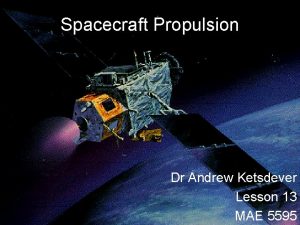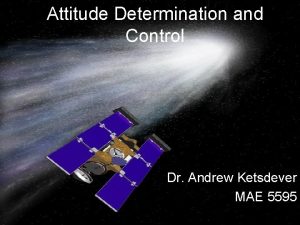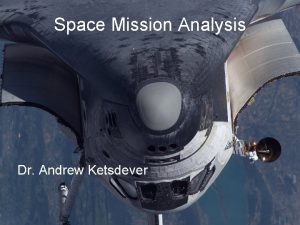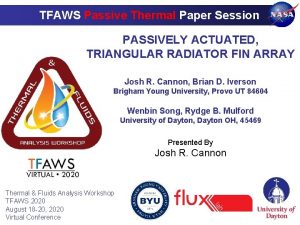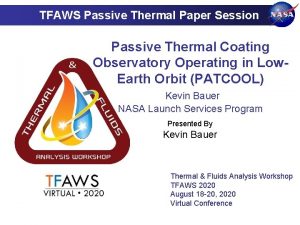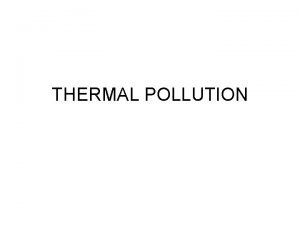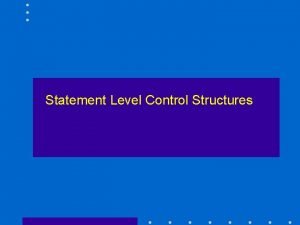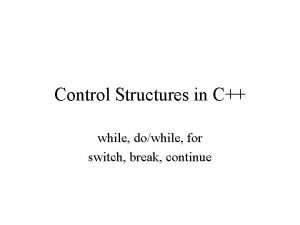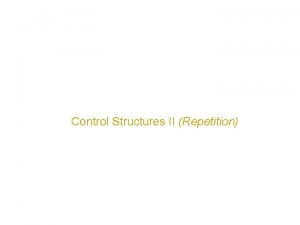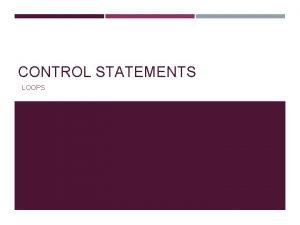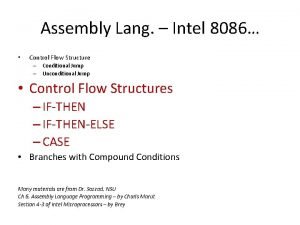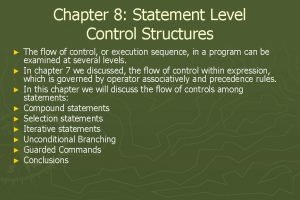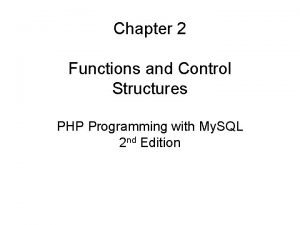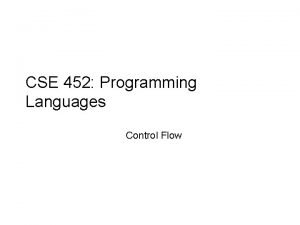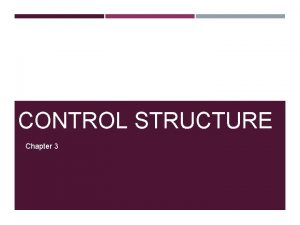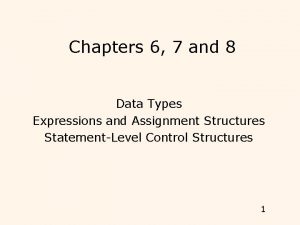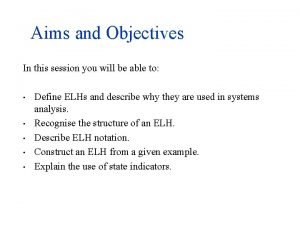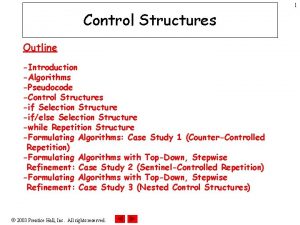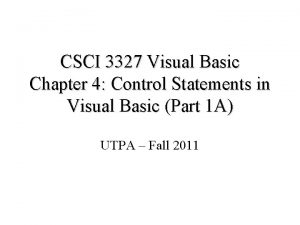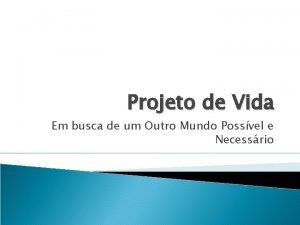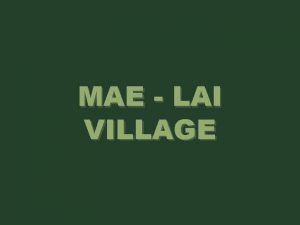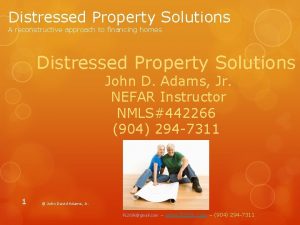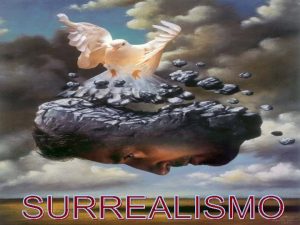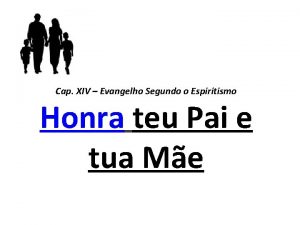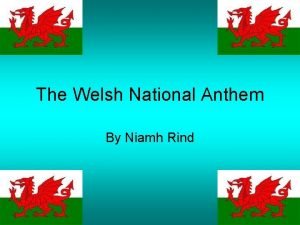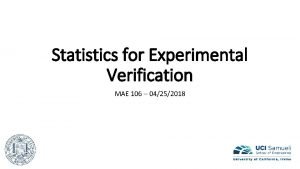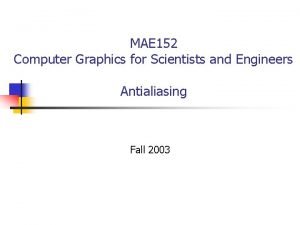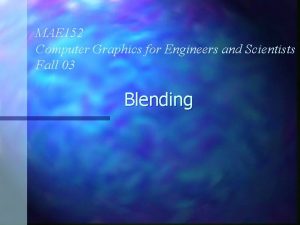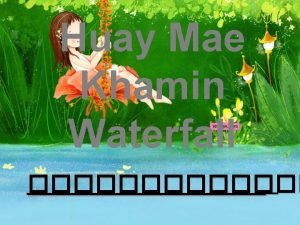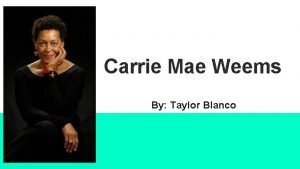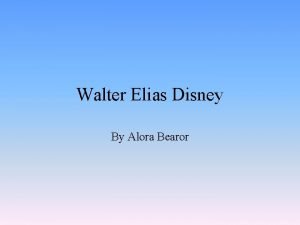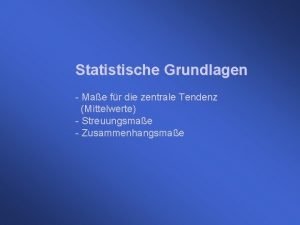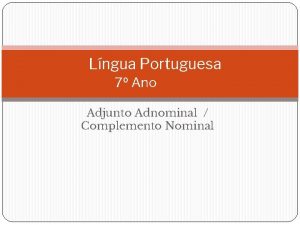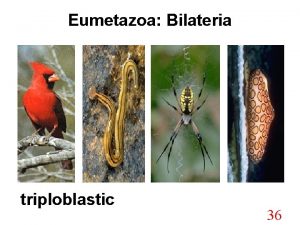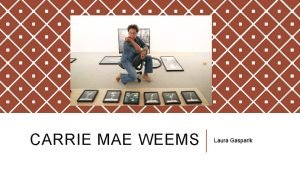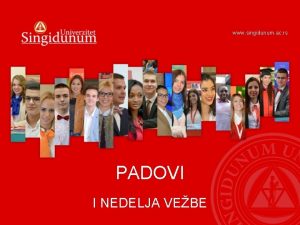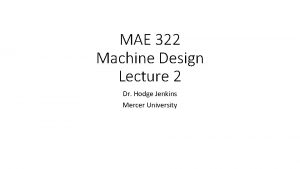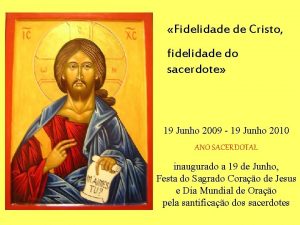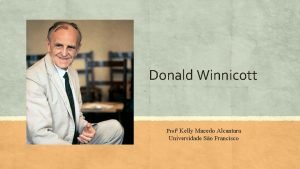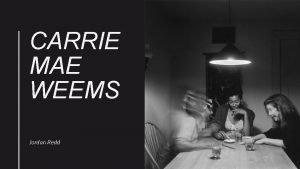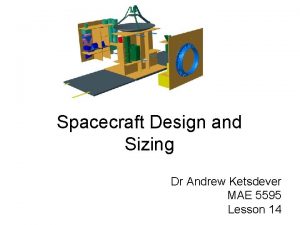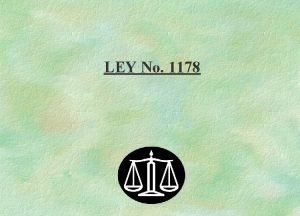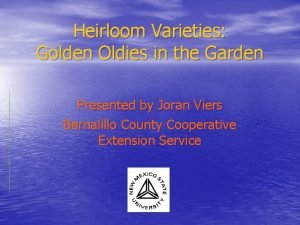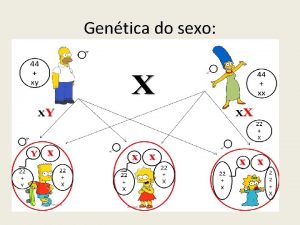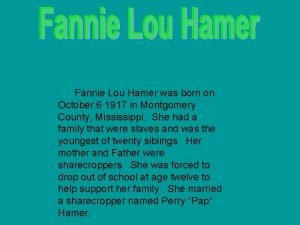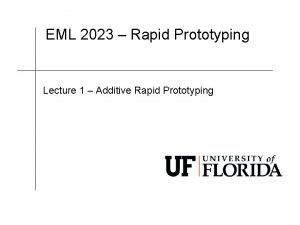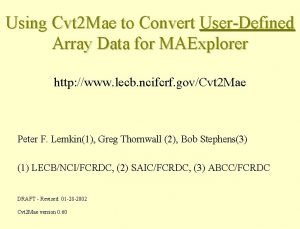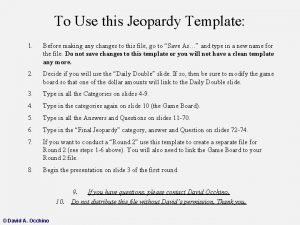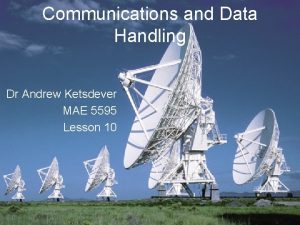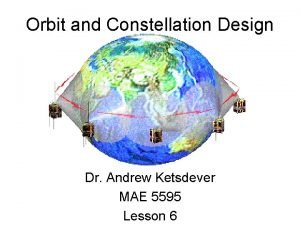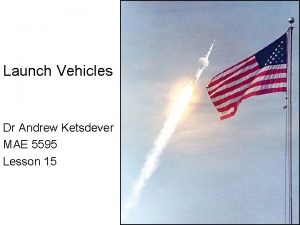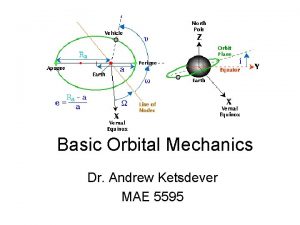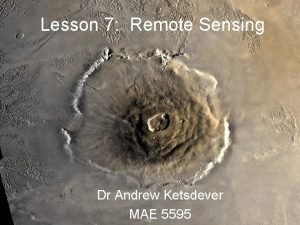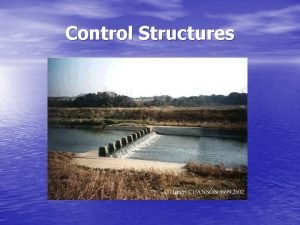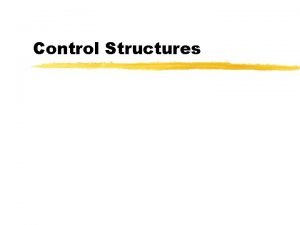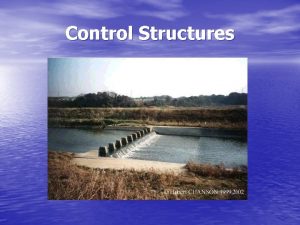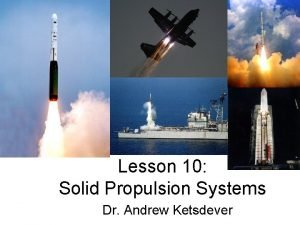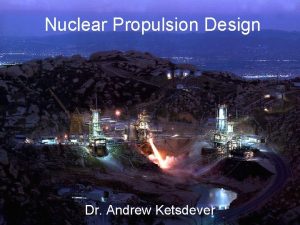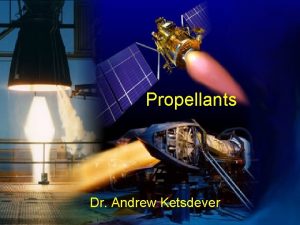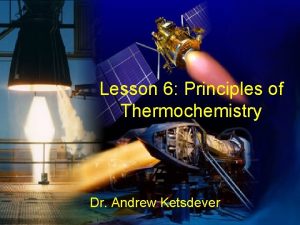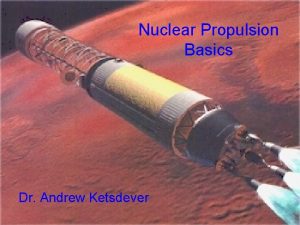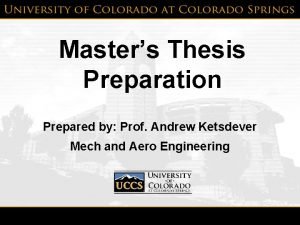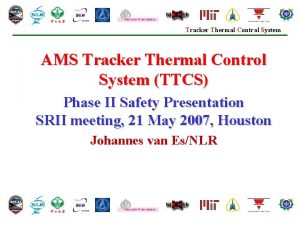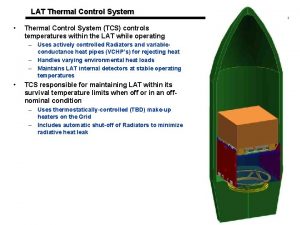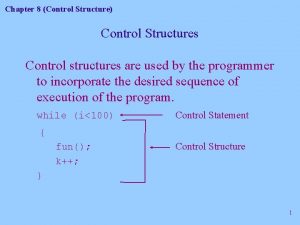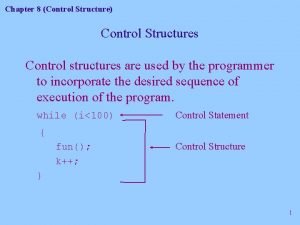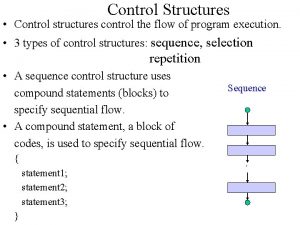Structures and Thermal Control Dr Andrew Ketsdever MAE































































- Slides: 63

Structures and Thermal Control Dr Andrew Ketsdever MAE 5595 Lesson 12

Outline • Structures and Mechanisms – Introduction – Structural Loads • Static • Dynamic – – Mechanics of Materials Material Selection Launch Structural Design • Thermal Control – Introduction – Thermal Loads – Design • Passive • Active

Structures and Mechanisms

Structures and Mechanisms Introduction • Structures – Mechanically supports all other subsystems • Provides load path and distribution – Attaches spacecraft to the launch vehicle • Isolation and vibration damping – Provides for separation from the launch vehicle – Provides shielding for components • MMOD, Radiation, AO – Satisfy all strength and stiffness requirements – Primary structure • Carries spacecraft’s major loads – Secondary structure • Support of wires, propellant feed lines, etc. • Brackets

Structures and Mechanisms Introduction • Mechanisms – Two applications • High cycle – Antenna gimbals – Solar array drives – Reaction wheels • Low cycle – Gravity gradient boom – Solar array or antenna deployment – Contamination cover removal

Structural Loads • Static (constant with time) – External • Weight of supported components during integration – Internal • Pressurized tanks • Mechanical preloads • Thermoelastic loads • Dynamic (time varying) – External • • • Transport to launch site Launch vehicle Acoustic loads Wind gusts Attitude control actuators – Internal • Thermal cycling • Mechanism operation

Mechanics of Materials • The 3 over-riding design criteria for space vehicle structures are: – Strength: ability to support a static load – Stiffness (Rigidity): measure of flexibility (need to avoid L/V natural frequencies) – Stability (Buckling): resistance to collapse under compression • For simplicity, we will consider only spacecraft that resemble beams

Strength Stress: Strain: Poisson’s Ratio: Young’s Modulus:

Stiffness • Natural frequency is the frequency at which an unforced, vibrating system will vibrate • When vibrating freely, a single degree of freedom system will always vibrate at the same frequency, regardless of amplitude

Stiffness • Without energy dissapation, harmonic motion will go on forever. Of course, things do quit vibrating eventually. • A damping force is one that resists vibration and dissipates energy, normally through heat (friction). • A viscous damping force is proportional to velocity; we typically assume viscous damping to simplify analysis. Assuming a spring is linear-elastic,

Stability • Theoretically, a linear-elastic column will buckle at a critical, or Euler Buckling Load, Pcr, given by • This equation applies only if the axial stress at buckling (Pcr/A) does not exceed the materials proportional limit. Otherwise, replace E with Et, the tangent modulus which is the slope of the stress/strain curve at the operating stress level (the buckling stress in this case).

Cyclic Failure • Fatigue failure is caused by repeated, cyclical loading of a component at a load well below ultimate or yield s Fatigue limit n-cycles It is difficult (or impossible) to accurately predict the actual fatigue limit for a given part. The only sure way is to test to failure.

Mechanics of Materials • Flexibility – Measure of how much a structure deflects under a load • Stiffness (Rigidity) – Inverse of flexibility – Below Elastic Limit • Material returns to initial length after stress removed • Material becomes plastic above the elastic limit • Material yields and has residual strain • Materials – Ductile • Yields substantially without failing – Brittle • Yields without much deformation

Mechanics of Materials Cantilever Beam in tension P tension x Cantilever Beam in bending P c Neutral axis x Moment b Neutral axis h M=Px Tension Neutral axis Compression

Mechanics of Materials P 1 Satellite Neutral axis P 2 x Tension LV interface Compression

Mechanics of Materials Shear Strain: G = shear modulus t

Structural Design • Design Stress x Factor Safety < Allowable Stress • Allowable Stress depends on – Type of stress – Material used

Material Selection

Material Selection

Material Selection Property 6061 -T 62 Al plate. 25 -2” A 286 Bar steel <2. 499” Ti-6 AI-4 V Bar 2” (annealed) Density (gm/cm 3) 2. 71 7. 95 4. 43 Young’s Modulus, E (103 MPa) 69. 0 201 110 Poisson’s ratio, n 0. 33 0. 31 Allowable Tensile Ultimate stress, Ftu (MPa) 290 896 923 Allowable compressive yield stress, Fcy (MPa) 240 590 903 Allowable Shear Stress, Fsu (MPa) 190 570 Thermal conductivity (W/m. K) 150 12 7. 3 Coefficient of thermal expansion, a, (10 -6 m/m/ºC) 22. 9 23. 0 8. 5 Corrosion resistance Good Excellent Weld-ability Good Fair Very Good Fair Machinability Adapted from Sarafin, Spacecraft Structures and Mechanisms, 1998.

Launch Profile 1. 2. 3. 4. 5. 6. 7. 8. Launch S-IC Inboard Engine Cut Off S-IC Outboard Engine Cut Off S-II Ignition S-II O/F Mixture Change (lower F) S-II Shut Down S-IVB Ignition (one J 2 engine) S-IVB Shut Down

Launch • Axial and Lateral Loads – Acceleration due to thrust • Typically increases with time due to launch vehicle mass reduction • Can be several to tens of g’s – Vibration • Random vibe • Shock (burst) – Liftoff – Staging – Acoustic • Sound pressure waves

LV Interface: Shock Ring • Needed a design to provide axial and lateral isolation to satellite payloads • Variation of axial shock ring – Increases the path the shock has to travel while providing parallel damping • All metallic load path • Aluminum construction for light payloads – Titanium for larger payloads • Easily manufactured and assembled • Integrates in a stacked configuration • Viscoelastic constrained layer damping on outer and/or inner circumference

Flexible Body Dynamics • Finite Element Method – Used to predict structural modes, natural frequencies, and responses to applied loads – Models of the structure with discrete degrees of freedom – Break a complex structure into simple structures that are easy to analyze – Matrix math Payload M 1 k 1 Oxidizer M 2 k 2 Fuel M 3 F(t)

Launch Vehicle Loads Power Spectral Density (PSD) Mean Square Accel. (g 2) Cumulative Mean-square acceleration PSD Power Spectral Density (g 2/Hz) Frequency (Hz) At a given frequency, the PSD is the slope of the function of cumulative mean square acceleration. The area under the acceleration PSD curve is equal to the overall mean square acceleration. Thus, the overall root-mean-square value equals the square root of the area under the PSD curve.

Launch Vehicle Loads Using a PSD curve • Given a PSD for a LV, for example, we’d like to know the acceleration experienced by our spacecraft • Miles’ Equation tells us this . .

Structural Design Secondary structures: Primary structures: • body structure • launch vehicle adapter • • • appendage booms support trusses platforms solar panels antenna dishes Tertiary structures: SSAM: Fig. 1. 1 • brackets • electronics boxes Structural components are categorized by the different types of requirements, environments, and methods of verification that drive their design – Primary structures are usually designed to survive steady-state accelerations and transient loading during launch and for stiffness – Designs of secondary and tertiary structures tend to be driven by stiffness, positional stability, and fatigue life

Structural Requirements • • Manufacture & Assembly (handling fixtures) Transport & Handling (cranes, dollies, transport to launch site) Testing (vibration, acoustic) Pre-launch (stacking and preflight checks) Launch • • • – – • Mission Operations (thrusters, attitude maneuvers) – • Steady state acceleration (typical max acceleration 6 g’s axial, 3 g’s lateral) Vibration and acoustic noise Shock from staging and separation Very benign compared to launch and testing Reentry

Structures Example: Thin-Walled Pressure Vessels • Thin walled vessel defined as having an inner radius to wall thickness of 10 or greater.

Structures Example: Cylindrical Pressure Vessels

Structures Example: Spherical Pressure Vessels

Structure Subsystem • How do you know the structure will meet the requirements? – Inspection • Is it built the way it was designed? • Are the right materials used? – Analysis • Finite element modeling – Test and Evaluation • Did the structure perform as designed?

Thermal Control Subsystem

Introduction • Thermal Control Subsystem – Maintain all spacecraft and payload components within their required temperature limits over the entire mission • Operational Limits • Survival Limits • Gradient Limits – Can be accomplished by active or passive means

Operating Temperature Ranges

Spacecraft Thermal Environment

Spacecraft Thermal Environment

Spacecraft Thermal Environment

Heat Transfer Methods • Conduction (Fourier’s Law) – Heat flow in a medium, generally solid • Convection – Heat flow using stirring medium, liquid or gas – May use gravity to stir passively

Heat Transfer Methods • Radiation (Stefan-Boltzman Law) – Electromagnetic (EM) energy through free space (mostly in the IR spectrum) Q = σεAT 4 where σ = S – B constant = 5. 67 x 10 -8 (W/m 2 K 4) ε = emmissivity (typically in IR spectrum) • Heat Flux

Design Options • Passive thermal control – Coatings: paints, mirrors – Insulation: multi-layer insulation (MLI) blankets • Alternating layers of aluminized Mylar and thin net • Often use Kapton for innermost / outermost layers (stronger) – Radiators: radiate waste heat to deep space • Locate radiators on S/C side not exposed or only partially exposed to Sun or Earth – Phase Change Devices: paraffin absorbs heat as it melts (latent heat of fusion) • For use next to equipment with high, short bursts of power – Thermal Isolators: isolate propellant lines, etc – Placement of components

Design Options • Active thermal control – Heaters and Thermostats – Louvers: modulate a radiator – Heat Pipes • Liquid near hot component evaporates • Moves to cold end of pipe and condenses • Wicking device or capillary action brings liquid back to hot end (active or passive) • Hard to test in 1 g – Cold Plate: cooling fluid passes through plate – Cryogenic systems: refrigerator (thermodynamic cycle) or vented gas – Attitude Maneuvers

TCS—Intro Thermal-Optical Properties e = % energy emitted with respect to a perfect black body. Usually averaged over IR range, e. IR • a = absorptivity, % of incident radiation absorbed Usually averaged over the solar range, a. SOL • r = reflectivity, % reflected. • t = transmissivity, % transmitted. • = reflectivity = absorptivity = transmissivity

TCS—Intro Thermal Analysis • Gray body – Assume a = e over entire spectrum of interest. Most real objects can be treated as gray bodies if we restrict the wavelength under consideration, e. g. solar spectrum (0. 3 – 3. 0 mm) or IR (3. 0 – 30. 0 mm). – Thus, a. SOL = e. SOL , a. IR = e. IR • S/C absorb most energy in the solar spectrum and emit in the IR. So when we compare materials, we’re interested in the ratio, – a. SOL /e. IR

Emissivity / Absorptivity vs Wavelength

Radiation Properties of Materials

Thermal Nodes and Networks • Thermal Networks – S/C thermal network is analogous to an electrical network. Instead of electrical nodes with electrical capacitance connected by electrical resistors/conductors, we have thermal nodes with thermal capacitance connected by thermal resistors/conductors. – Thus, we can use basic laws such as Ohm’s Law, Kirchhoff’s Law to solve thermal networks. • Thermal Nodes – To conduct thermal analysis of a complex system we break it into a set of finite subvolumes called nodes.

Types of Thermal Nodes • Diffusion Nodes – Most commonly used in a thermal network. They have finite thermal mass. Represents normal material/components whose temperature can change due to heat flow in/out of the node. – Temperature of the node depends on nodal heat capacitance, net heat flow into/out of the node, time. – Example: Battery Box • Arithmatic Nodes – Zero thermal mass, don’t exist physically. Useful in constructing thermal models. Can change temperature instantly. Can be used for bolts, low mass insulators, coatings. – Example: Thermal coating • Boundary Nodes – Infinite thermal mass, represent a source or sink. Temperature can’t change no matter how much heat is added. T= constant. – Example: Deep space. • Number of nodes – The more nodes you have in a network model, the potentially more accurate (within the bounds of diminishing returns). But the more nodes, the more computationally intensive the analysis.

TCS—Design Network Example Deep Space N 4 G 3 Cond. N 5 G 4 rad N 3 G 2 conduction Physical Model N 2 G 1 radiation Sun N 1

TCS—Design View Factors • A view factor, F, is the fraction of energy leaving one surface that strikes another surface. • The sun is far enough away that it can be considered to be a point source of energy. We can use the cosine law to determine the fraction of energy hitting a surface. • For LEO orbits, Earth is close enough that this assumption doesn’t apply to Earth-source energy. Instead, we must use view plane geometry to determine the fraction of energy striking a surface. Luckily, we don’t have to integrate over both surfaces. There analytical solutions for simple shapes (planes, spheres).

TCS Preliminary Design Process

TCS Preliminary Design Process

TCS—Design SMAD Thermal Analysis • Balance heat in and heat out → Also must consider heat generated internally, or heat energy converted to other forms

TCS—Design Spacecraft Thermal Equilibrium Calculations Model spacecraft as a spherical satellite with planar solar arrays. Find equations for equilibrium temperature of the solar arrays and the spacecraft body.

TCS—Design Solar Array Thermal Equilibrium Calculations - Absorbed energy Direct Solar Albedo Earth IR

TCS—Design Solar Array Thermal Equilibrium Calculations - Emitted energy - Generated energy (taken out of array)

TCS—Design Solar Array Thermal Equilibrium Calculations - Maximum temperature – all sources - Minimum temperature – only Earth IR

TCS—Design S/C Body Thermal Equilibrium Calculations - Maximum temperature - Minimum temperature where:

TCS—Design Thermal Equilibrium Example Perform the preliminary thermal analysis for a spacecraft with the characteristics given in the table. Calculate worst case hot and cold temperatures. Identify any assumptions you make. Cylindrical Spacecraft Shape Orbit Altitude Electrical Energy Dissipation, Qw 1 m radius 3 m height 800 km 200 watts

TCS—Design Thermal Equilibrium Example • Find the radius of an equivalent sphere with same surface area as the cylinder: , • Find , Ka, and F:

TCS—Design Thermal Equilibrium Example • Use the following table of parameters: Parameter Hot Value Cold Value Source Gs 1418 1326 SMAD q. I 258 216 237 21 W/m 2 QW 200 Given 0. 3 0. 8 Typical values for preliminary thermal analysis a 0. 35 0. 25 SMAD

TCS—Design Thermal Equilibrium Example • Worst Case Hot will occur at local noon with the spacecraft directly overhead

TCS—Design Thermal Equilibrium Example • Worst Case Cold will occur at local midnight.
 Propellantless propulsion
Propellantless propulsion Andrew ketsdever
Andrew ketsdever Andrew ketsdever
Andrew ketsdever Andrew ketsdever
Andrew ketsdever Thermal energy section 3 using thermal energy
Thermal energy section 3 using thermal energy Thermal transfer vs direct thermal printing
Thermal transfer vs direct thermal printing Homologous structures example
Homologous structures example Hardware and control structures
Hardware and control structures Passive thermal control
Passive thermal control Passive thermal control
Passive thermal control Ciptm
Ciptm Statement level control structures
Statement level control structures Intro.php?aid=
Intro.php?aid= Setprecision in c++
Setprecision in c++ Repetition control structure in c++
Repetition control structure in c++ Types of control structures
Types of control structures If else in assembly language 8086
If else in assembly language 8086 Statement level control structures
Statement level control structures Control structures in php
Control structures in php Iteration control structures
Iteration control structures If a do…while structure is used:
If a do…while structure is used: Iteration control structures
Iteration control structures Iteration control structures
Iteration control structures Pseudocode outline
Pseudocode outline Control structure in visual basic
Control structure in visual basic Talia bettcher
Talia bettcher Tenho que lutar tenho que arriscar
Tenho que lutar tenho que arriscar Nú sai do ventre de minha mãe musica
Nú sai do ventre de minha mãe musica Mae lai village
Mae lai village Freddie mac ucd
Freddie mac ucd Fannie mae homepath nightmare
Fannie mae homepath nightmare Mae west salvador dali
Mae west salvador dali Evangelho segundo o espiritismo honrar pai e mãe
Evangelho segundo o espiritismo honrar pai e mãe Coronilla de las virtudes de maria
Coronilla de las virtudes de maria Account chek
Account chek Welsh national anthem words
Welsh national anthem words Mae 106 uci
Mae 106 uci Mae 152
Mae 152 Blending function in computer graphics
Blending function in computer graphics Huay mae kamin waterfall
Huay mae kamin waterfall Carrie mae weems bio
Carrie mae weems bio Alora disney
Alora disney Zentrale tendenz
Zentrale tendenz Nas orações camila tem muito amor à mãe
Nas orações camila tem muito amor à mãe Flatworm example
Flatworm example Blue notes carrie mae weems
Blue notes carrie mae weems Mae sabaki
Mae sabaki Vento perdido
Vento perdido Mae 322
Mae 322 O que é hardware e software
O que é hardware e software Nossa senhora mãe dos sacerdotes
Nossa senhora mãe dos sacerdotes Biografia de winnicott
Biografia de winnicott Jordan gasparik
Jordan gasparik Bespiegeling kunsten in samenhang samenvatting
Bespiegeling kunsten in samenhang samenvatting Na mae
Na mae Mae kelly
Mae kelly Mae sizing
Mae sizing Sumariante
Sumariante Hopi yellow watermelon
Hopi yellow watermelon Homens daltônicos e hemofílicos herdam a doença da mãe
Homens daltônicos e hemofílicos herdam a doença da mãe Philip larkin fannie
Philip larkin fannie Eml 2023 uf
Eml 2023 uf 2 mae
2 mae Ub mae flowsheet
Ub mae flowsheet
